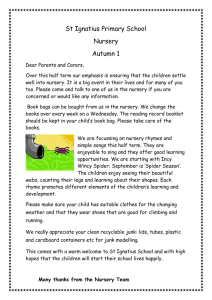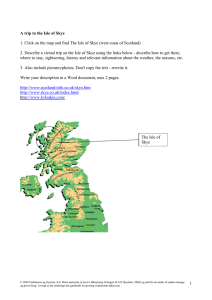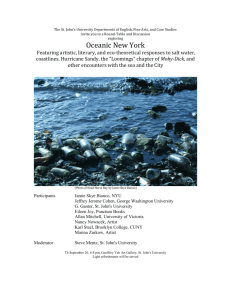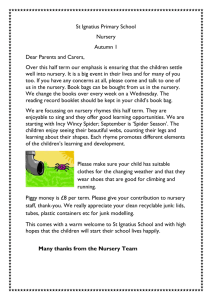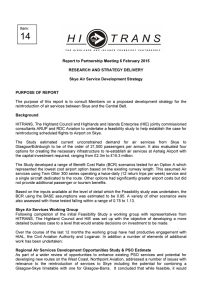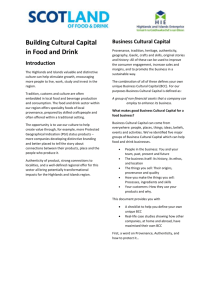Using Big Book Planning to promote involvement.
advertisement
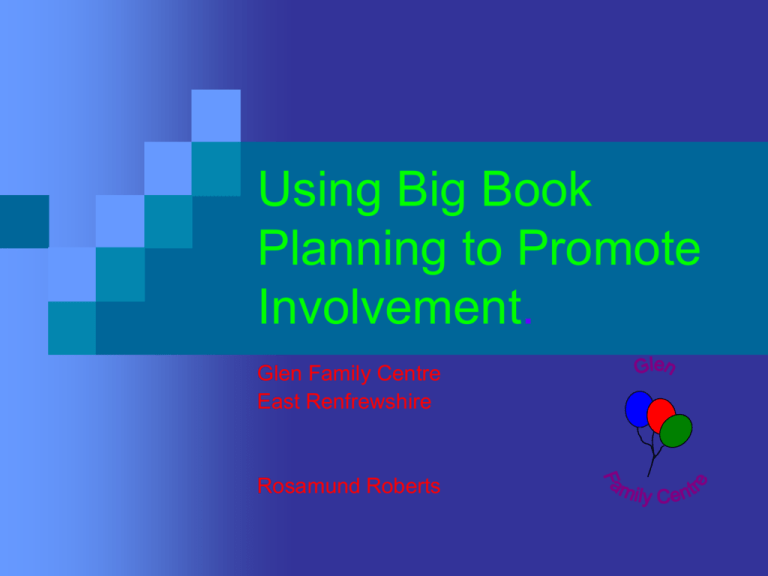
Using Big Book Planning to Promote Involvement. Glen Family Centre East Renfrewshire Rosamund Roberts A Curriculum for Excellence In our endeavours to encourage children to be successful learners, confident individuals, effective contributors and responsible citizens Big Book planning helps us through the consultation process. “Consultation with children is important because : it creates a closer match between the child and the curriculum it is experiencing it builds self esteem and positive attitudes when the learner is involved in decision making it increases intrinsic motivation, that stays with a child throughout life children have a right to be treated with respect as individuals. We can show respect by valuing their thoughts and opinions.” (Claire Warden 2006) A Curriculum for Excellence Successful learners Confident Individuals With enthusiasm and motivation for learning determination to reach high standards of achievement openness to new thinking and ideas Able to use literacy, communication and numeracy skills use technology for learning think creatively and independently learn independently and as part of a group make reasoned evaluations link and apply different kinds of learning in new situations With self respect a sense of physical, mental and emotional well being Secure values and beliefs Ambition Able to relate to others and manage themselves Pursue a healthy and active lifestyle Be self aware Develop and communicate their own beliefs and view of the world Live as independently as they can Assess risk and take informed decisions Achieve success in different areas of activity Effective contributors Responsible citizens With an enterprising attitude resilience self reliance Able to communicate in different ways and in different settings work in partnership and in teams Take the initiative and lead Apply critical thinking in new contexts Create and develop Solve problems With respect for others Commitment to participate responsibly in political, economic, social and cultural life Able to develop knowledge and understanding of the world and Scotland’s place in it understand different beliefs and cultures make informed choices and decisions Evaluate environmental, scientific and technological issues Develop informed, ethical views of complex issues A Curriculum for Excellence Science Languages Mathematics Expressive Arts Big Book Planning Health & Wellbeing Religious & Moral Education Technologies Social Subjects Child at the Centre 2 2.1 Children’s experiences Our children enjoy and are actively involved in learning through play. They are fully engaged, highly motivated and interact well during activities. Children can plan and initiate their learning experiences. They exercise choice and take increasing responsibility for their own learning. Our centre uses imaginative and appropriate methods to ask children about their learning. Our staff listen to children and act upon their views and interests. Children feel successful and are confident, and they can contribute appropriately in our centre. 5.1 The Curriculum starts from the needs of the individual is designed to enable all children to make progress in the key aspects of their learning and development. promotes challenge, enjoyment, personalisation and choice in learning. has breadth, balance and depth and sufficient flexibility to meet the needs of individuals. takes full account of local and national advice and leaves scope for staff to introduce well-considered innovations, and for children to follow their interests. We reflect as a staff on the curriculum we provide and improve the range and quality of the experiences for all children, the impact of these experiences on children and the outcomes which they achieve. Children can plan and initiate their learning experiences. Child at the Centre 2 5.3 Meeting learning needs 5.4 Assessment for learning Our approaches to development and learning are relevant and challenging and take full account of children’s experiences, interests and individual ways of learning. Our children are able to make choices, follow their interests and are absorbed in play. Our programmes are flexible to enable individuals to progress at their own pace. We plan high-quality learning experiences using our understanding of children’s learning and development and of the learning outcomes. We know and respond to individual needs and interests and are clear about what we expect children to learn. We build on and extend appropriately children’s previous learning. Child at the Centre 2 5.5 Expectations and promoting achievement We provide a stimulating and motivating learning environment and have high expectations for achievement. Our children’s high aspirations show in an enthusiastic approach to playroom activities, progress and achievements. Their high levels of motivation and depth of engagement demonstrate a positive attitude to learning. The Teacher’s Role – Leading the Learning. Research into this sort of child-centred approach : Claire Warden – Talking & Thinking Floorbooks 2006 LTS Early Years Online – Fintry Nursery developing a documentation approach. Iram Siraj-Blatchford : Thinking about thinking, sustained shared thinking various web articles and powerpoints Leadership – staff training, consultation, developing an approach to suit your setting Self - Evaluation – what is the impact on children’s learning and progress, the learning environment, the quality of the provision? Collaboration – at team meetings each member of staff shares their big book and talks about what the children have been learning, we share ideas about possible lines of development and how we can each support the interests and needs of individual children. Assessment & Monitoring – overview of what the children are learning, sit down with the children and ask them to talk through their big book, talk about what they have learned “I can….” Big Book Planning – The Process. The starting point for each big book is the learning outcomes for that block. This ensures that the big book is focused firmly on learning and teaching. Each group creates their own big book. The first step is to make a cover which includes contributions from all children in the group. This gives the children ownership. Next the learning outcomes are shared with the children and parents in the big book, parental newsletter and displayed throughout the nursery. Big Book Planning – The Process. The next step is to establish what children already know, their previous learning. An opening question will be formulated and the first page in the book will record children’s thoughts and ideas which can then be used to measure progress and learning at the end of the book. Staff then evaluate children’s responses and plan Possible Lines of Development (PLOD) Children contribute by suggesting learning experiences for that week for a particular area of the nursery Big Book Planning – The Process. Subsequent pages will include photographs and examples of children’s work. Children actively participate in the learning experiences they help to plan, they then add pictures to the big book to demonstrate their learning and talk about what they have learned. Children begin to see that their thoughts and ideas are valued, what they say can be written down, and it can be re-read later. Big Books give valuable opportunities to revisit learning in depth in addition to making the connection between the written and spoken word. Big Book Planning – The Process. Self assessment. At the end of each week the learning is reviewed. The visual learning outcomes are added alongside children’s pictures and work and children are asked “What did you learn in nursery this week?” Big Book Planning – The Process. What did you learn in nursery this week? We are learning to taste, try and talk about different flavours. We are learning to sort things that go together into groups. We are learning to use our hands and other parts of our bodies to find out how things feel and use words like soft/hard, rough/smooth, wet/dry to talk about them. I learned to make playdough – it was soft. I learned to taste things that were different flavours. I learned to put the numbers in the right order – up to 14! I learned to sort out numbers. I learned to match all the colours in the Sudoku. Big Book Planning – The Process. Peer assessment Big Books provide great opportunities for peer assessment. As everyone feels valued and their contributions are celebrated it is easy to talk about each other’s work. “Which picture do you like the best?” “What do you like about it?” I like Sofia’s picture, it makes me so happy. Big Book Planning – The Process. Language skills : talking, listening, reading, writing. Big Books promote language skills in numerous ways with children reflecting on their learning, talking about their ideas and experiences, listening to each other, writing their name, drawing pictures and “reading” speech bubbles. Practitioner’s Perspectives What impact has Big Book Planning had on the children’s learning? …the children are more motivated in carrying out their learning, they follow through their ideas more. …they are all really involved in their play, if they have planned particular activities they carry out exactly what they said they would do. …they follow up their learning at home as well, you get a lot of feedback from parent’s saying that they want to explore things in more depth at home. …there’s more excitement about what they are doing in their groups and they look at everybody’s book and follow what everyone is learning.. …all the children are able to have ownership of the big book, they can speak to you, write it down or draw pictures, they’re all involved, and they’re so proud of it. What do the children think? They’re for everyday so that we can learn different things. Amy It helps us to learn things. Skye What is the big book for? For we can learn things in it. - Ethan For sticking things in, like pictures all about nursery. Sofia It’s for the juicy apples, we look at the book and we talk about what to learn. Cara For looking at and doing pictures. - Peter It’s all about what we’re learning. Simon What do the children think? We tell the teacher our ideas and we draw a picture and sign it. Because we say things and we write things to see what we’re doing Leo How does it help you to learn? Joanne writes down all the things we are learning Skye When we write things in the book then everyone will know - Ben Because we can learn more things and more things - Amy What do the children think? Look at the front of our big book, that one’s my picture. This is what we are doing all week. Skye I remember that, it was when we went to Queen’s Park to learn about different colours of insects. - Amie Skye - What does that one say? Leo, can you read that? Leo - No, I can’t read yet. You need to get to the shape page and see all the shapes I made - Ben We just made this all by ourselves. Natalie Amie – That was when we were tasting different flavours.. Skye – and I said “Tasting different yoghurts” Amie – and we had pomegranates. Let’s Talk What makes an establishment effective and what are the optimum conditions in which to grow successful learners, confident individuals, responsible citizens and effective contributors?


